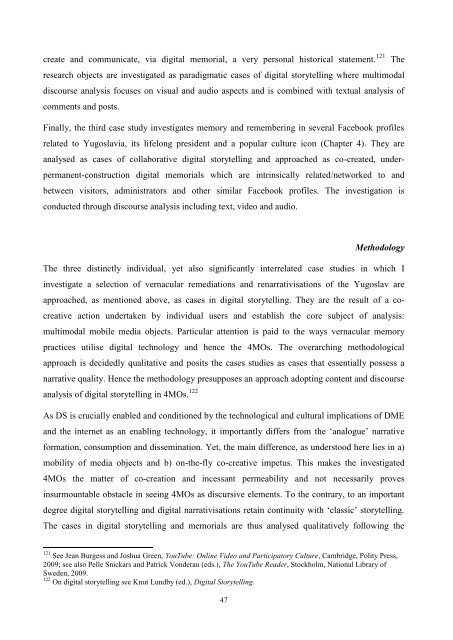UNIVERSITY OF NOVA GORICA GRADUATE SCHOOL ...
UNIVERSITY OF NOVA GORICA GRADUATE SCHOOL ...
UNIVERSITY OF NOVA GORICA GRADUATE SCHOOL ...
Create successful ePaper yourself
Turn your PDF publications into a flip-book with our unique Google optimized e-Paper software.
create and communicate, via digital memorial, a very personal historical statement. 121 The<br />
research objects are investigated as paradigmatic cases of digital storytelling where multimodal<br />
discourse analysis focuses on visual and audio aspects and is combined with textual analysis of<br />
comments and posts.<br />
Finally, the third case study investigates memory and remembering in several Facebook profiles<br />
related to Yugoslavia, its lifelong president and a popular culture icon (Chapter 4). They are<br />
analysed as cases of collaborative digital storytelling and approached as co-created, underpermanent-construction<br />
digital memorials which are intrinsically related/networked to and<br />
between visitors, administrators and other similar Facebook profiles. The investigation is<br />
conducted through discourse analysis including text, video and audio.<br />
Methodology<br />
The three distinctly individual, yet also significantly interrelated case studies in which I<br />
investigate a selection of vernacular remediations and renarrativisations of the Yugoslav are<br />
approached, as mentioned above, as cases in digital storytelling. They are the result of a cocreative<br />
action undertaken by individual users and establish the core subject of analysis:<br />
multimodal mobile media objects. Particular attention is paid to the ways vernacular memory<br />
practices utilise digital technology and hence the 4MOs. The overarching methodological<br />
approach is decidedly qualitative and posits the cases studies as cases that essentially possess a<br />
narrative quality. Hence the methodology presupposes an approach adopting content and discourse<br />
analysis of digital storytelling in 4MOs. 122<br />
As DS is crucially enabled and conditioned by the technological and cultural implications of DME<br />
and the internet as an enabling technology, it importantly differs from the ‗analogue‘ narrative<br />
formation, consumption and dissemination. Yet, the main difference, as understood here lies in a)<br />
mobility of media objects and b) on-the-fly co-creative impetus. This makes the investigated<br />
4MOs the matter of co-creation and incessant permeability and not necessarily proves<br />
insurmountable obstacle in seeing 4MOs as discursive elements. To the contrary, to an important<br />
degree digital storytelling and digital narrativisations retain continuity with ‗classic‘ storytelling.<br />
The cases in digital storytelling and memorials are thus analysed qualitatively following the<br />
121 See Jean Burgess and Joshua Green, YouTube: Online Video and Participatory Culture, Cambridge, Polity Press,<br />
2009; see also Pelle Snickars and Patrick Vonderau (eds.), The YouTube Reader, Stockholm, National Library of<br />
Sweden, 2009.<br />
122 On digital storytelling see Knut Lundby (ed.), Digital Storytelling.<br />
47

















